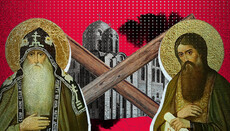How the Apostolic Church helped the needy

From helping widows to ransoming captives – how charity (diakonia) was organized in the early Christian communities of the apostolic period.
Today, social service plays an important place in the life of the Church. Most news on Orthodox resources is dedicated to helping the poor, refugees, the sick, supporting the armed forces, organizing charity collections and fairs. All this is important: mercy and care for one's neighbor have always been and remain an integral part of Christian life.
However, it is worth remembering that social service is not only visible actions. It is deeper: in compassion, prayer, and inner sacrifice.
If only external manifestations remain, there arises a feeling of "emptiness". The constant flow of charitable news sometimes creates an impression of artificiality, and the Church itself risks being perceived merely as a social service.
To understand the true essence of mercy, it is worth turning to the experience of the first Christian communities. Already in apostolic times, charitable service (diakonia) was a natural continuation of life in Christ, organically combining spiritual and practical service.
Origins of Christian philanthropy
Various forms of charity existed in both the Hellenistic and non-Christian worlds. But the early Church Fathers and the teachings of the apostles spoke of diakonia as an expression of philanthropy not just as a social virtue, but as a property of love that comes from God and manifests itself in caring for every person.
The Apostle Paul writes: "the kindness and love of God our Savior appeared" in the incarnation of the Word (Titus 3:4). Because "God so loved the world that He gave His only begotten Son, that whoever believes in Him should not perish but have everlasting life" (John 3:16).
Christianity broke down boundaries, erased racial and social differences, proclaiming: "There is neither Jew nor Greek; there is neither slave nor free; there is neither male nor female: for you are all one in Christ Jesus" (Galatians 3:28). Love in practice was not limited to any group.
Christ Himself in the Gospel of Matthew says: "I was hungry and you gave Me food; I was thirsty and you gave Me drink; I was a stranger and you took Me in; I was naked and you clothed Me; I was sick and you visited Me; I was in prison and you came to Me... truly I say to you, as you did it to one of the least of these My brethren, you did it to Me" (Matthew 25:35-40). These words became not just a spiritual testament but also a practical guideline for the entire life of the community.
The Clementines, a monument of early Christian writing of the 2nd century, provide a vivid definition of charity: "The greatness of charity lies in the fact that it implies love for every person... Charity loves everyone and does good to them because everyone is a person, regardless of their personal beliefs... A philanthropic person does good even to their enemies... Everyone is a neighbor to everyone... For the good and the evil, friend and foe – all are people. Therefore, he who does charity should imitate God, who does good to the righteous and the unrighteous."
Love for one's neighbor, expressed through helping those in need, visiting the sick and imprisoned, supporting widows and orphans, was the heart of the Church's mission and a vivid testimony of its uniqueness. Pagans were amazed by the selflessness: "See," they said, "how they (Christians) love one another... and how ready each one is to die for another" (Tertullian, "Apology").
Main Forms of Social Service
Almsgiving and charity. Almsgiving was a central element of community life. From the Apostolic Constitutions to the writings of St. Cyprian of Carthage, it was emphasized that giving alms was not just an act of goodwill but a religious duty with spiritual significance. Funds were collected in public treasuries (aerarium, according to Tertullian) to help each other in various circumstances.
Care for widows and orphans. Widows bore the honorable title of "God's altar," and their support was considered a sacred duty of the community. The Roman community, for example, in the mid-3rd century cared for 1,500 widows and needy individuals. Such practice strengthened the sense of brotherhood and demonstrated to the world the uniqueness of Christian care for the most vulnerable.
Assistance to the sick and infirm. Deacons and deaconesses visited the sick, delivered food, and provided spiritual support through prayer. During epidemics (plague in Alexandria and Carthage), as Eusebius of Caesarea writes, "only the Christians... demonstrated their sympathy and philanthropy in action; they cared for the dying and buried the dead... gathering crowds of the poor and hungry throughout the city, they distributed bread to them", often sacrificing their own lives, while pagans abandoned their sick.
Care for prisoners. Christians visited prisoners, especially those who suffered for their faith. They prayed for them, brought food, and, according to Tertullian, "did not hesitate to bribe prison guards to gain a meeting" with the imprisoned. They also sought to free brothers who had been sentenced to work in mines by sending them words of comfort. Emperor Licinius issued a special decree prohibiting this, which shows the significance of such actions.
Care for slaves and workers. Christianity did not abolish the institution of slavery but ensured the spiritual and social rights of slaves. Slaves were accepted into community life, allowed to hold church positions, and supported in need. Communities encouraged work: "if anyone will not work, neither shall he eat" (2 Thessalonians 3:10), creating a system where the able-bodied provided for their minimum through work, and the incapable through the compassion of the community.
Hospitality and assistance to strangers. Christians welcomed strangers, supported poor communities, and brethren in danger. Hospitality was an expression of mercy and part of missionary strategy, strengthening the network of mutual assistance between communities.
Ransom of captives. Churches collected funds to ransom Christians who had been captured. Bishop Cyprian of Carthage, upon learning of the captivity of Christians in Numidia, sent 100,000 sesterces, reminding of the Lord's words: "I was naked and you clothed Me" (part of the quote from Matthew 25:36, which St. Cyprian applied to the situation of captivity).
Mutual assistance between communities. Communities supported one another. For example, the Antiochian community, foreseeing famine, collected aid for poor Christians in Judea. The Apostle Paul organized collections in Macedonia and Achaia, and the Roman church regularly helped those working in mines. Saint Ignatius the God-bearer in his letters emphasized the active participation of communities in each other's fate.
Conclusion
The experience of the Apostolic Church clearly shows that social service was not limited to the formal distribution of alms. Christians managed to avoid the danger when mercy becomes a means of self-glorification or an external obligation. On the contrary, their diakonia was born from the depth of faith and from a living sense of brotherly love in Christ.
This is what distinguished them from pagan and philosophical forms of charity: help was not a handout, but a recognition of real brotherhood and unity in Christ.
Thus, what might have been confusing turned into a testimony of a different life, where service to one's neighbor became the natural breath of the Church.
This is the main lesson of the apostolic period: social service is not an external obligation, but a form of Christ-centered love that transforms both the individual and the entire society.











